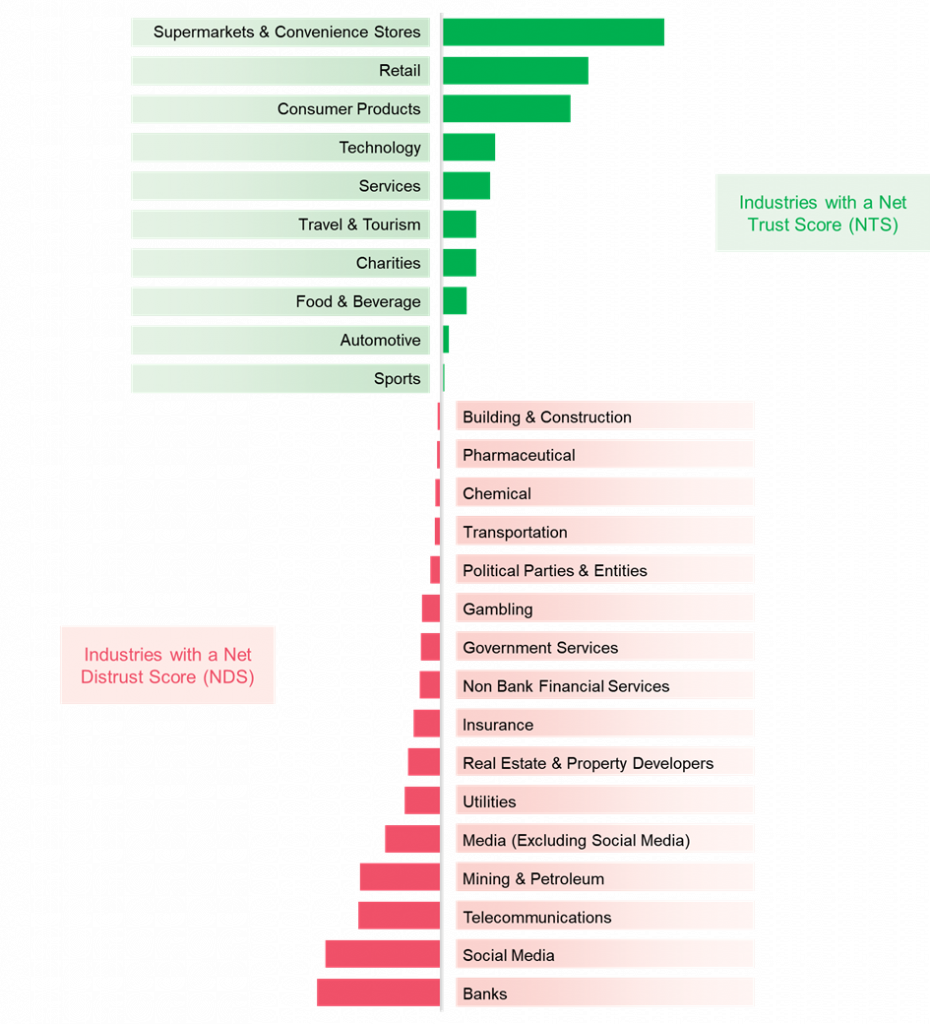Supermarkets, Retail, Consumer Products and Technology are the industries with the highest Net Trust Scores

The newly released June 2021 edition of the Roy Morgan Risk Report, available now, shows that Supermarkets have emerged as the most trusted industry in Australia during the COVID-19 pandemic over the last year led by high Net Trust ratings for Woolworths, Coles and ALDI – all three are in the top four most trusted brands.
The newly released June 2021 edition of the Roy Morgan Risk Report, available now, shows that Supermarkets have emerged as the most trusted industry in Australia during the COVID-19 pandemic over the last year led by high Net Trust ratings for Woolworths, Coles and ALDI – all three are in the top four most trusted brands.
To learn more about the latest Roy Morgan Risk Report join us for our webinar titled Winners & Losers: Trust & Distrust in a post-COVID world. Joined by social scientist Dr Ross Honeywill, we will explore how TRUST and, crucially, DISTRUST are materially impacting the performance of brands across ten key sectors in the post-COVID era, and the implications for risk profiling your own company in the near term to be presented at 11am—12pm on Tuesday July 27, 2021.
Retail continues to rate highly as the second most trusted industry just ahead of Consumer Products in third while one of the big improvers over the last year during which many have spent considerable time working from home has been Technology – now in fourth place overall.
However, although these four industries are the clear standouts a majority of 16 of the 26 industries that we measure are more distrusted than trusted – an increase from two years ago. The four most distrusted industries include Banks, Social Media, Telecommunications and Mining & Petroleum.
Roy Morgan research shows that distrust is one of the most significant, yet least recognised risks to Australian business and society in general.
For many people, seeing widespread distrust in action has come as a surprise. But Roy Morgan analysts recognised several years ago that something was building in society which wasn’t being captured by traditional measures. A major ongoing research program has revealed the corrosive effects distrust can have.
It is important to note that most industries – even those with high Net Trust or high Net Distrust – include a mix of trusted and distrusted brands. For example, despite being part of the most distrusted industry of Banking, ING and Bendigo Bank are in the top 20 most trusted brands and CUA was one of the best improvers over the past year. At the other extreme, Amazon is the 4th most distrusted brand despite being part of the strong Retail industry.
Industries with the largest improvement in ranking compared to 12 months ago were:
- Technology, up 6 places, the largest jump, and
- Government Services, up 5 places.
Industries with the largest drop in ranking were:
- Insurance, down 15 places, the largest fall
- Banks, dropping 8 places
- Non-Bank Financial Services, down 6 places, and
- Automotive, down 4 places.
Whilst key drivers of trust differ across industries and brands, those trusted tend to be perceived to be genuinely committed to consistently high-quality customer experience, making all interactions across all touchpoints easy and positive for all customers. They are perceived to provide high quality products and services, are reliable and fair with their pricing.
At the other end of the spectrum, key drivers for distrust in industries and brands also vary greatly, with those distrusted often perceived to be greedy and overly focused on profit, dishonest and misleading, ripping off customers and unethical.
Net Trust/Distrust Score by Industries: April 2020 – March 2021

Source: Roy Morgan Single Source (Australia). Risk Monitor, April 2020 – March 2021; n=21,833.
Key brands to drive the high Net Trust Scores for the leading industries include Woolworths, Coles, ALDI, IGA & Foodland (Supermarkets), Bunnings, Kmart, Myer, Big W & Target (Retail), Samsung, Sony, Nike, Lush & Cotton On (Consumer Products) and Apple, Microsoft, Dell, HP & Atlassian (Technology).
Roy Morgan CEO Michele Levine explains the Roy Morgan Risk Monitor can provide an early warning to firms who risk losing pace with their rivals when distrust levels are on the rise but yet to hit the bottom line:

“Roy Morgan’s Risk Monitor isn’t ‘just a marketing or comms issue; it goes to the heart of corporate governance in an era in which a rumour can spread around the world in an instant via social media networks and do incalculable damage to a brand’s reputation – whether fairly or not.
“Distrust is a driver of consumer behaviour and should be on the Risk register of every publicly listed company in Australia given the danger it can pose to a brand’s good reputation in the corporate realm – and also amongst existing and prospective customers.
“Our work has uncovered the scale of distrust that exists for many brands and businesses. It’s not uncertainty or even an absence of trust. It is something separate and more powerful, an active sense that we were foolish to trust too much, and it cannot be ignored.
“For brands and businesses that experience a rising level of distrust it can lead directly to customer churn, loss of market share, and a plummeting share price. The example of AMP over the last three years is instructive as a once highly respected and trusted business has faced a series of scandals that has translated into a collapse in the share price from nearly $5.50 in early 2018 to only a smidge above $1 today – a share price drop of around 80%.
These insights are drawn from the ongoing Roy Morgan Risk Monitor based on over 1,800 interviews each month to measure levels of trust and distrust in more than 900 brands across 26 industry sectors. Respondents are asked which brands and companies they trust, and why, and which brand and companies they distrust, and why. The survey is specially designed to be open-ended and context-free, i.e. unprompted.
To gain a greater understanding of Roy Morgan’s Risk Monitor or to explore the results for specific industries and brands contact Roy Morgan. View the March 2021 edition of the Roy Morgan Risk Report.
View previous releases looking at Net Trust Score by Industries below:
Bunnings, ALDI and Woolworths on top in Net Trust ScoresBunnings, ALDI and Woolworths Australia’s most trusted brands
MORE INFORMATION
Michele Levine – direct: 03 9224 5215 | mobile: 0411 129 093 | Michele.Levine@roymorgan.com
View the 2021 Risk Report.
Margin of Error
The margin of error to be allowed for in any estimate depends mainly on the number of interviews on which it is based. Margin of error gives indications of the likely range within which estimates would be 95% likely to fall, expressed as the number of percentage points above or below the actual estimate. Allowance for design effects (such as stratification and weighting) should be made as appropriate.
| Sample Size | Percentage Estimate |
| 40% – 60% | 25% or 75% | 10% or 90% | 5% or 95% | |
| 1,000 | ±3.0 | ±2.7 | ±1.9 | ±1.3 |
| 5,000 | ±1.4 | ±1.2 | ±0.8 | ±0.6 |
| 7,500 | ±1.1 | ±1.0 | ±0.7 | ±0.5 |
| 10,000 | ±1.0 | ±0.9 | ±0.6 | ±0.4 |
| 20,000 | ±0.7 | ±0.6 | ±0.4 | ±0.3 |
| 50,000 | ±0.4 | ±0.4 | ±0.3 | ±0.2 |
